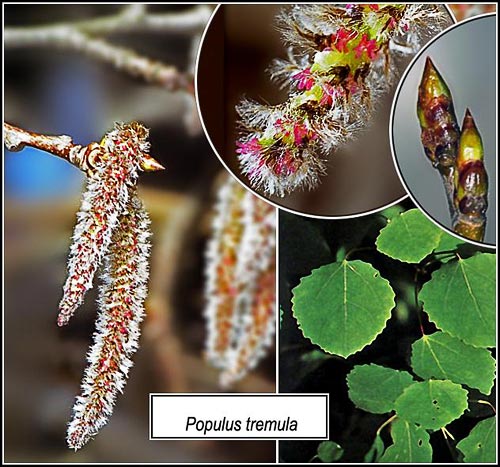Relatives
Populus tremula L. - Common Aspen, European Aspen.
Taxonomic position.
Family Salicaceae Lindl. genus Populus L.Synonymy.
Populus pseudotremula N. Rubtz.Morphology and biology.
Deciduous tree up to 30-40 m tall. Trunk bark brownish-grey, grey-green, light; that of young specimens smooth, old ones finely fractured. Leaves alternate, 4-7 cm diameter, obtusish, with rounded base, crenate at margin, glabrous or sparsely pubescent when young, long petiolate. Petioles laterally compressed in upper part, equal to or longer than leaf blade. Leaves of stool shoots are large (up to 15 cm) and subcordate. Monoecious plant with small, inconspicuous, unisexual flowers aggregated in catkins. Male and female catkins pendulous, 4-15 cm long. Floral glumes with long grey hairs at margin. Fruit is a very small nutlet provided with a bunch of hairs (plume).Anemophilous. Anemochore. Propagates by seeds and stool shoots. Flowers in April - early May, before leaves come out; mature fruits in late May - June.
2n = 38, 57, 76.
Distribution.
Europe (forest zone except for northernmost and southernmost areas); European part of Russia (except for extreme north and south); Crimea; Caucasus, Kazakhstan (north and east); Central Asia (Eastern and Central Tien Shan); West and East Siberia (except for northern areas); Far East (except for Chukotka, Anadyr and Koryak Upland); Mongolia (north); China; Korea (north).Ecology.
Mesophyte. Photophilous. One of the most widespread trees, occuring from forest-tundra to steppes, in Caucasus mountains reaches 2,400 m a.s.l. Distributed almost throughout the forest zone, only avoiding the most arid continental areas, as an admixture in different forest types or forms aspen forests. The great bulk of aspen forests are secondary, growing on burned and felled areas.Use and economic value.
Technical, medicine, melliferous. Wood used in building and furniture production, match production. Buds and bark used in folk medicine as resolvent, antiseptic, anaplerotic. The study of its intraspecific variability, selection and bringing under cultivation aspen forms which grow fast and are poorly damaged by moulds is of great economic significance.References:
Gubanov IA., Kiseleva KV., Novikov VS., Tikhomirov VN. 2003. Illustrated Manual of the Middle Russia Plants. V.2. Moscow: KMK. 665 p. (In Russian).Koropachinskiy IYu., Vstovskaya TN. 2002. Woody plants of the Asian part of Russia. Novosibirsk: Publishing House of Siberian Division of the Russian Academy of Science, Branch "Geo". P.197-199. (In Russian).
Sokolov SI., Svjaseva OA., Kubli VA. 1977. Ranges of trees and shrubs of the USSR. V.1. Leningrad: Nauka. P.84-85. (In Russian).


